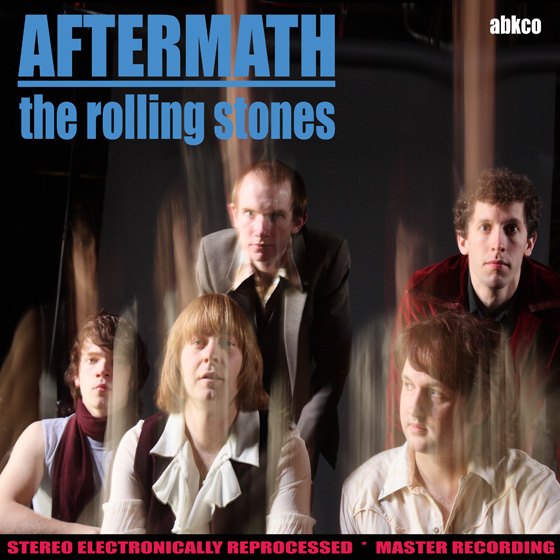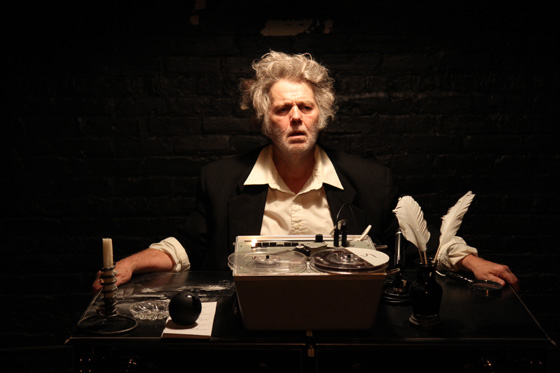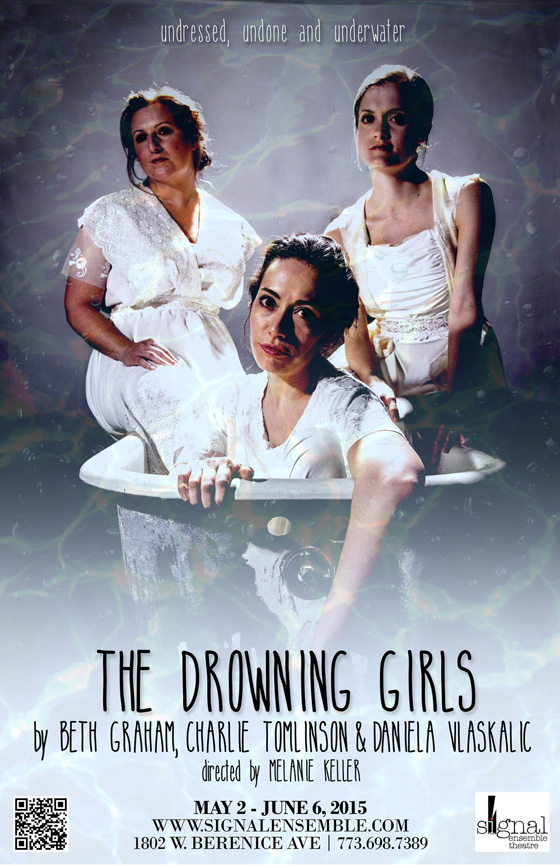| « Remy Bumppo's Love and Information Blends Memories, Paranoia, Human Connections | Theater Wit's Watson Intelligence Succeeds as a Tech-Driven, Time-Flipping Invention » |
Feature Wed Oct 07 2015
Outgoing Signal: A Grateful Essay About the End of a Theater Company
By Johnny Knight

Signal Ensemble company portrait, 2009. Photos by Johnny Knight.
Tonight I witnessed the beginning of the end. Signal Ensemble Theatre, the company whose productions I've photographed more than any other, announced that this season will be their last.
Over the past 10 years I have taken production photos during dress rehearsals for 25 of their shows. That's 25 times in my life I have shown up at their space (on a quiet corner on Berenice Avenue near Ravenswood) and been their first audience, watching the show through my lens as they performed it. Besides the production photos, I've done 27 of Signal's PR/poster photo shoots, 13 headshot sessions for their ensemble members, and five weddings that involved at least one member of their artistic family.

Aftermath, 2010. Lobby display.
I know these people well.
So it was a shock when my wife texted me the mournful message that Signal would be shutting down forever after two more shows.
The reason? Well, two reasons.

Accidental Death of an Anarchist, 2011.Reason 1. Live theater is an art form that costs a lot of money and takes in a lot less. Not exactly breaking news, but I had thought of this company as bulletproof when it came to financial matters. I know all arts groups struggle with money, yet I never got the sense that they were hurting. Maybe because they always paid me on the night of the shoot. (Many non-Equity theaters humbly ask me to wait until after opening, when ticket revenue pours in and fills the dry well of their production budget. I'm used to that.) Signal never made excuses; they just paid me on the spot. Every time.
Reason 2. Their company members have made it to the next level. Some have done it as actors getting cast by union theaters, sure, but many had advanced their lives in other ways — by having children, or having second children, or upgrading their day jobs to careers. And in the words of Managing Director Stephanie Ingram, "We're not young any more."
At our production shoot tonight, after I hugged my Signal friends and patted their backs and sighed in a sad but understanding way, I looked around the lobby at the myriad posters and production photos I've shot for them. I realized that if the Internet suddenly ceased to exist — if my website and Facebook page and Instagram account were all wiped out — I could live with that.

The Real Inspector Hound, 2010.
Because this room. If I had gone my entire photographic career and made nothing but the work in this room, I'd call that a successful career. This room. THIS IS MY BOOK.
For 10 years, this lovely group of people paid me money in exchange for making pictures. They gave me the chance to work in so many different genres. (They asked me to recreate every Rolling Stones album cover, for God's sake!) Every one of those posters was technically a freelance marketing gig, but every one gave me the satisfaction of a work of finished art. More importantly, each one promoted another, bigger, much more complicated work of art. I was given the chance to pitch in on their artistic process, to encourage the public to see their shows. And the best part is, the people who gave me that chance were charming, talented and kind.

Krapp's Last Tape, 2011
Nice work if you can get it, right?
It's uncanny. I can immodestly say, time and again, the photos I've produced for Signal have been outstanding. I've worked for a lot of theater companies, and I'm proud of the work I've done for almost all of them. But Signal has consistently brought out the best in me. There has to be something special about this company that has over and over and over again allowed me to do my best work. Tony Ingram's poster concepts always get my heart racing in anticipation of the shoot, puzzling out how I'm going to create the look he wants. Mark Hurni and Julie Ballard's lighting designs paint their black box with brilliant visual style. Melania Lancy's detailed sets seem to make Signal's tiny space like the inside of the Tardis, bigger and more complex than I thought possible.
And that ensemble of actors. Man. I've spent thousands of hours looking at their faces while editing photos, picking out the best angle for Joe Stearns' beautifully bent nose. Marveling at the simultaneous innocence and cynicism in Vince Lonergan's wrinkled squint. Sighing warmly at the ageless beauty of Melanie Keller's smile. Aaron Snook's shapeshifting ingenuity, Georgann Charuhas's scrappy fragility... The list goes on and on.

Motion, 2012

The Drowning Girls, 2015.This company has given me an abundance of raw materials to make the art I love. And of course, the work I do is a drop in the bucket compared to the shows themselves. Actors, producers, directors, designers slave over a show for months, years really. I show up for a few hours with my camera and then move on to my next project. Still, because my medium is more permanent than theirs, I get to be the one who immortalizes their efforts. I hope my photos are an adequate tribute.
So go see the last two shows at Signal this season. (I saw the dress run of Butcher tonight — it's brilliant and brutal.) When you step into the lobby, take a look at the posters on the wall. Not just to stroke my ego, although that will be a nice side effect. Think about how these posters are the tip of the iceberg. Appreciate the ambition and vision and hard, hard work by the Signal family that stand behind all those images.
If only it could go on forever.

Waiting for Godot, 2005.
~*~
Johnny Knight is a Chicago photographer who works with many theater companies as well as business clients. You can see his work here.








